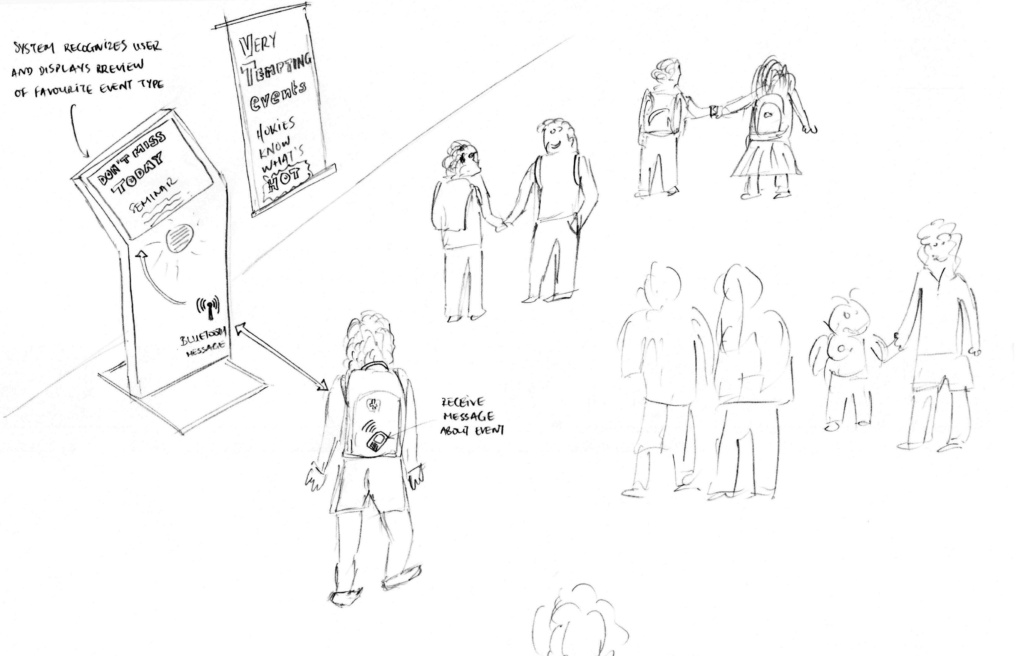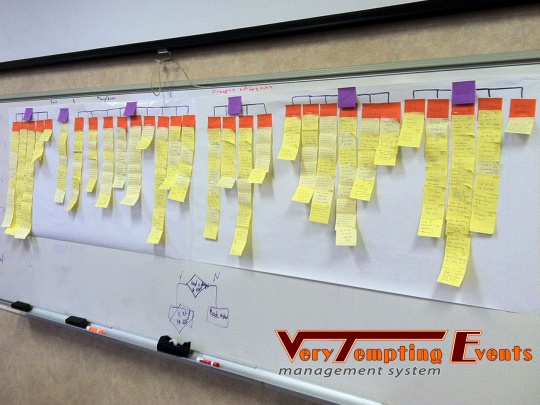USABILITY ENGINEERING EVENTS MANAGEMENT
In this project I worked in a group of six to address a real-world problem, which in our case was an integrated event management system for the whole university. We followed the Wheel model life-cycle (analyze, design, prototype, evaluate) giving emphasis on user experience, and applied contextual inquiry to identify user requirements.
Design Process
We started by brainstorming about potential project ideas and eventually identified that the lack of a unified, campus-wide event management and advertising system was a common hassle in our student experience. We verified that this was also a common pain point for the university administrators by contacting the Dean of the Graduate School, who agreed to serve as our client. Based on our vision of the optimal system, we compiled a system concept statement: "The VT (Very Tempting) Events Info Kiosk will provide Hokies with an easy and quick way of finding out what is happening around campus. The kiosk will be placed in strategically located spots within the University and will be accessible 24 hours a day. The scope of the system will be to provide a unified access point to all the events and initiatives that take place within the University. It will resolve the current problem of different departments and organizations having to post their announcements using different resources. A central database will enable organizers to schedule and administer events easily, and allow users to quickly find out what is happening and where. The proposed design will be primarily fun to use, providing intuitive access to information, and having as an ultimate goal to act as a point of attraction to passers-by. Finally, it will enhance the sense of University community." We then created a technical summary of the system, identifying also three main stakeholders: the event administrators, the event posters, and the event seekers.
In the next step, we conducted contextual inquiry and contextual analysis for the proposed VT Events Info Kiosk. During the inquiry procedure, we gathered supporting evidence through our client, but also through multiple interviews with our stakeholders (after identifying work roles), artifact gathering (e.g., existing systems and paper forms used), and observation interpretation (using ethnographic methods). During interviews, we valued the voice of the customer in order to better understand their activities in context to their current work practice and improve their effectiveness. The contextual analysis section featured a flow model illustrating the current event coordinating and advertising process we aimed to improve. Additionally, contextual data and artifact analysis provided the basis for compiling and completing a work activity affinity diagram (WAAD).
In the next step, we extracted the requirements from the affinity diagram and created some design-informing models. The requirements list derived by scanning the WAAD multiple times and eliciting user needs, mainly based on user complaints and burdens with the current work process. Then, we created multiple models for the existing system as well as for the proposed system, including a social model (emotions, thoughts, expectations, and social interactions between users), usage models (how the work gets done for each task), task interaction models (capturing the actions of each work role), information object model (important application objects in the design of the system), and work environment models (the social and physical setting in which the work is performed). For each model, we described a usage scenario of an existing event management process and a design scenario of the envisioned system. We then compiled a barrier summary, as a centralized view of all barriers listed within the models previously discussed, which allowed our design team to easily see common deficiencies in work practice and user performance which could be applied to the design of the new system.
After identifying the groups that the system was being designed for (i.e., hosts and attendees) and modeling the different tasks in the process of hosting an event, our design goals were to create a streamlined process for reserving a space and advertising, while also ensuring that event hosts have a positive experience throughout. The design goals closely address the needs of the persona we were designing for, Max, a university student planning an event. We got involved in a rapid ideation and sketching session, during which we generated 80 ideas pertaining to the proposed Very Tempting Events Management System. We then got involved in conceptually designing (sketching) the system from different perspectives, using our mock scenario and our persona in mind. We ended up with multiple storyboards capturing the emotional, ecological, and interaction perspectives of the user experience. The final outcome of the design stage was to create the wireframes (using mainly Omnigraffle) detailing the interactions Max would need to have in order to reserve a campus space for his event.
In the rapid prototyping phase, we focused on developing prototypes which can be quickly replaced or changed in line with design feedback. This feedback derived from colleagues and users as they worked with the prototype to accomplish set tasks. We opted for a Vertical Prototype, as this gave us the opportunity to test and refine the core application features and the design aspects of the interface at an early stage, saving considerable development effort. The steps we followed to build the VP were: 1) determine the core functions of the system; 2) develop key modules incorporating all the required functions; 3) design and develop wireframes to showcase these functions; 4) add functionality to illustrate the interactive features (using Adobe Director). We eventually tested our system through pilot runs using the high-fidelity prototype, which allowed us to identify some deficiencies and missing functionality. The identified problems were documented and addressed through this iterative process. Finally, we ran a formative evaluation of another class project using cost-importance analysis, which is not reported here.
OTHER DESIGN PROJECTS
Similar design projects during my PhD studies
-

University-Restaurant Insight Finder
Design ProjectInformation Visualization project using Yelp datasets



















